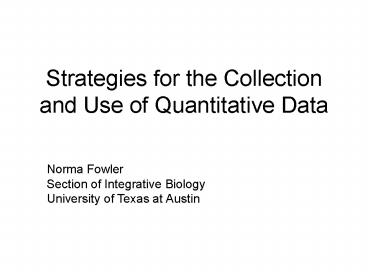Strategies for the Collection and Use of Quantitative Data - PowerPoint PPT Presentation
1 / 21
Title:
Strategies for the Collection and Use of Quantitative Data
Description:
How can we obtain and use quantitative data most efficiently, given inevitable ... 2 treatments: fenced exclosure & control. 1 cluster of plants = 1 plot ... – PowerPoint PPT presentation
Number of Views:63
Avg rating:3.0/5.0
Title: Strategies for the Collection and Use of Quantitative Data
1
Strategies for the Collection and Use of
Quantitative Data
Norma Fowler Section of Integrative
Biology University of Texas at Austin
2
Why are quantitative data not used as widely and
effectively as they might be?limited
funding......so...How can we obtain and use
quantitative data most efficiently, given
inevitable funding constraints?
3
- Some reasons why quantitative data are not used,
or are used incorrectly or inefficiently (other
than funding limitations) - data not collected
- data collected but not analyzed
- inefficient sampling and experimental designs
- statistically invalid sampling and experimental
designs
4
- Some reasons why quantitative data are not used,
or are used incorrectly or inefficiently (other
than funding limitations) - data not collected
- data collected but not analyzed
- inefficient sampling and experimental designs
- statistically invalid sampling and experimental
designs
5
- data not collected the lack of long-term
monitoring - long-term monitoring
- reveals whether a management practice is working
- provides baseline data for future studies and
future management - is often relatively inexpensive
- but....
- it is not as glamorous as new initiatives
- the need often outlasts the duration of project
funding, the employment of a staff member, etc.
6
- Some reasons why quantitative data are not used,
or are used incorrectly or inefficiently (other
than funding limitations) - data not collected
- data collected but not analyzed
- inefficient sampling and experimental designs
- statistically invalid sampling and experimental
designs
7
data not analyzed
- because bookkeeping and number-crunching arent
as much fun as field work? - because the funding has run out?
image from http//www.sostitle.com/
8
- Some reasons why quantitative data are not used,
or are used incorrectly or inefficiently (other
than funding limitations) - data not collected
- data collected but not analyzed
- inefficient sampling and experimental designs
- statistically invalid sampling and experimental
designs
9
- the three most common types of important design
problems seem to be - replication
- no replication
- no statistically valid replication
- inefficient replication
- randomization
- no randomization
- statistically invalid randomization
- number of statistical units v. number of variables
10
- the three most common types of important design
problems seem to be - replication
- no replication
- no statistically valid replication
- inefficient replication
- randomization
- no randomization
- statistically invalid randomization
- number of statistical units v. number of variables
11
- replication
- An example of invalid, valid but inefficient, and
more efficient designs - 3 habitat types
- open cluster along
- savanna of woody plants a drainage
for simplicity, assume we can only make
measurements on 36 plants
12
replication
valid but inefficient design 2 plots
per habitat type, 6 plants per plot
statistically invalid design only 1 plot per
habitat type
13
replication
alternate approach no plots, 12 plants per
habitat type stratified random plant
locations
statistically more efficient design 4 plots
per habitat type, 3 plants per plot
14
- the three most common types of important design
problems seem to be - replication
- no replication
- no statistically valid replication
- inefficient replication
- randomization
- no randomization
- statistically invalid randomization
- number of statistical units v. number of variables
15
randomization
- some really bad ideas
- ignore the whole issue and hope it goes away
- throw hoops with your eyes shut
- sample whenever there is a place to pull off the
highway - sample every 10 m
- wander around and sample at what feels like
random intervals to you
16
randomization
- Humans dont seem to be able to generate random
numbers. - Solutions
- random number tables correctly used
- random number generators in computer packages
17
- the three most common types of important design
problems seem to be - replication
- no replication
- no statistically valid replication
- inefficient replication
- randomization
- no randomization
- statistically invalid randomization
- number of statistical units v. number of variables
18
number of statistical units v. number of variables
- Too many characters on too few statistical units
( plots or plants, depending on the design).
Why? - Big plants are big all over usually little is
gained by measuring gt1 size-related variable. - Environmental variables are often so highly
correlated with each other that little is gained
by measuring some of them. - If plot is the statistical unit of replication,
more plants per plot usually add little to the
power of the analysis.
19
- An example of a statistically valid, relatively
efficient design the effects of deer browsing on
Streptanthus bracteatus
2 treatments fenced exclosure control
1 cluster of plants 1 plot
6 plots per treatment in yr 1, 9 plots per
treatment in yr 2
images from http//www.wildflower2.org/NPIN/Galler
y/ and http//www.thenorthview.org/recreation/anim
als/deer.html
20
- preliminary study of 11 size-related measures of
Streptanthus bracteatus - stem basal diameter predicted dry biomass very
well (R2 0.95), - the other 10 variables did not have
to be measured in the experiment, - and....
- using this estimate of initial biomass greatly
increased the power of the analysis
image from http//www.tpwd.state.tx.us/news/tv/vnr
/archive/0307
21
(No Transcript)































